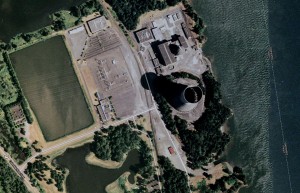
The Trojan nuclear power plant, located a few miles north of Kalama on the Oregon side of the Columbia River, stopped producing power in 1993. Image from Google Maps.
Recent events in Japan have a lot of people thinking about the safety of nuclear power. Fortunately for those of us in the Pacific Northwest, nuclear power plants are in short supply.
The closest nuclear power plant to Vancouver – and the only commercially operated one still running in the Northwest – is the Columbia Generating Station.
The plant, located 10 miles north of Richland, is operated by Energy Northwest – a joint operating agency with 28 utility members, including Clark Public Utilities. According to Energy Northwest’s website, the station is a 1,150-megawatt boiling water reactor that uses nuclear fission to produce heat. Its primary fuel source is uranium.
The Nuclear Regulatory Commission issued the station a 40-year operating license in 1983. Energy Northwest is applying for an additional 20 years which would continue its operations to 2043.
For more information on the station and how it works, visit the Energy Northwest website.
Closer to home is the decommissioned Trojan nuclear power plant, located a few miles north of Kalama on the Oregon side of the Columbia River.
According to The Oregonian, the plant was operated by Portland General Electric, first started producing commercial power in May 1976, closed its doors in January 1993 and at one point produced a quarter of Oregon’s electricity.
Spent fuel is still stored on site, but PGE notes that the installation was designed to withstand foreseeable hazards, including a major subduction zone earthquake off the coast of the Pacific Northwest.
“This could include a subduction zone earthquake off the Oregon coast of a magnitude similar to the one that shook Japan on March 10, 2011 as well as more localized seismic events in the vicinity of the storage area,” officials wrote in a release.
Additionally, spent fuel is stored in canisters that were designed to be moved and cooled using a “passive convection system containing no moving parts, and does not require a power source.”
According to PGE, tsunamis aren’t much of a risk at the Trojan site.
“As was demonstrated during the tsunami generated by the Alaskan earthquake of 1964, tsunami effects at the mouth are dissipated inside the river due to the characteristics of the estuary. Therefore, the risk of tsunami inundation at the Trojan site was considered low enough that no tsunami plan was required when the facility was licensed,” the release said.
The site is also prepared for flooding of the Columbia River.
“The [storage site] is also not considered vulnerable to other postulated flooding events on the nearby Columbia River, including a failure of the Grand Coulee Dam. Even if the site were to flood, water would also serve to provide passive cooling to the casks,” officials said in a release.
Gadget guide, Gizmodo.com created an in-depth timeline of the Crisis in Japan.
Check out video interview with two Vancouver people who experienced the Japan earthquake firsthand.









